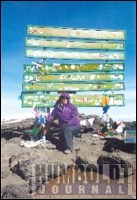When Melissa Prystupa told her husband and kids that she was going to climb Mount Kilimanjaro, they voiced some morbid concerns.
"They thought I was going to die," Prystupa said with a laugh.
She didn't die; in fact, Prystupa made it all the way to the summit of the world's tallest freestanding mountain. She even had time to pose for a picture in the thin air, nearly 20,000 feet above the plains of northeast Tanzania.
Prystupa, who lives in Muenster, climbed the mountain in early March with 15 other people who together raised nearly $100,000 for WaterCan, a Canadian charity that helps provide clean water to four countries in East Africa. One of those four countries is Kenya, where Prystupa visited several villages to see the effects of WaterCan's work up close.
Prystupa was introduced to WaterCan through an annual fundraiser that Elite Salon & Spa holds on their behalf every Earth Day; Aveda, a major beauty products supplier to the spa, is also one of WaterCan's biggest supporters. These connections led Prystupa to the Mount Kilimanjaro trip and a once-in-a-lifetime experience.
"One of the most important things is providing basic water education," Prystupa said. "Making sure that what's done is sustainable over the long term."
Prystupa raised $7,000 over the course of seven or eight months prior to leaving for Africa in late February. There were barbeques, raffles at Elite Salon & Spa, where she works, and countless other fundraisers that saw her raise $2,000 more than her goal of $5,000.
There was also a significant amount of physical training that Prystupa had to go through to prepare for the climb; you can't just walk off the street and climb Mount Kilimanjaro, after all, especially if you're someone who's never done anything of the sort before.
In fact, Prystupa went through a training program for six months that was designed to help prepare her for the climb.
"I exercised but had never really done much hiking or anything like that," Prystupa said.
"There were lots of stairs to climb, lots of incline on the treadmill, lots of squats and cardio," she said. "I did that for a good six months, sometimes 20 minutes a day, sometimes 45 minutes or even a little more. Sometimes I would do weights but it was mostly about cardio training."Finally, at the end of February and after long months of preparation, it was time to go. After a long flight that took her through several countries, Prystupa arrived in Tanzania, where the mountain sits close to the border with Kenya. It was there that Prystupa got a good first look at how much things change from the ground to the summit.
She described an ascent up the mountain that began on wide-open plains and ended with glaciers and snow. In between were rainforests and large areas of little more than rock and dirt, reminders of the mountain's volcanic past.
Even though the climbers had guides and porters along for help, and even though Thomson Safaris boasted a successful climb rate of close to 100 per cent, there was no getting around the painful adjustment to the thin air.
"At the beginning you go up and down a little bit just to get used to the altitude," Prystupa said. "Even so you would get nauseous and have really bad headaches because of the altitude. There was one guy with us who just fell over and started throwing up one day. He said it felt like when you get the spins when you drink too much."
Even though she'd done those six months of training, it wasn't quite enough to prepare her for the climb itself.
"There was way more incline than what I'd trained for, and we'd hike for nine hours a day instead of one or two," Prystupa said.
Although most of the climb up was relatively standard - "Like climbing a steep hill," Prystupa said - the final ascent to the summit was a little more nerve-wracking. It was done in the middle of the night to make sure the climbers would be able to see the sun rise from the summit, but that meant climbing up steep rocks in the dark, with no harness or restraints.
"I didn't look to either side of me because there was a drop," Prystupa said. "You just keep your eyes on the person in front of you."
A stress fracture in her foot that developed during training could have been a major problem, but Prystupa was saved by applying patches of ginsing to her feet that she'd gotten from Haus of Stitches in Humboldt.
"My foot didn't bother me at all, and I thought it would because I had been in a lot of pain before," Prystupa said. "It was amazing how well the ginsing worked."
When the group finally reached the summit, there wasn't much time for celebrating; groups are only allowed between five and 10 minutes at the top to avoid the onset of altitude sickness. For Prystupa, that was more than enough time.
"Once I got to the top, I was ready to go back down," she said with a laugh.
Back down she went, and after a one-day safari she was on a plane back home to Saskatchewan, where her family was more than happy to see she'd made it back, and in good spirits.
"It was fantastic," Prystupa summarized.




